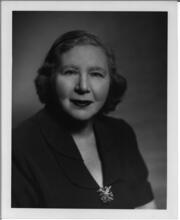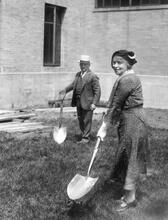Tamar De Sola Pool
Tamar De Sola Pool’s family came from Israel to America when she was a teenager but retained its Zionist spirit, speaking Hebrew at home. After graduating from Hunter College in 1913, Pool taught comparative literature at Hunter from 1914 to 1917. She served as president of the New York chapter of Hadassah from 1929 to 1935 and national president from 1939 to 1943. Beginning in 1934, she worked with Hadassah’s Youth Aliyah program to rescue Jewish children from Europe and resettle them in Palestine. She also collaborated with her husband on two books, Is There an Answer? about Jewish faith after the Holocaust, and An Old Faith in the New World, about their congregation’s 300-year history.
Tamar de Sola Pool dreamt of a socially and economically just world where people consistently acted toward one another with good will, fairness, and faith. She believed that a solution to the world’s problems would lead to the eradication of Jewish persecution and a global understanding that the Jewish people needed an independent state. She entreated the nations of the world to cooperate with one another, to live together peacefully before God, and to create a new world order. In pursuit of the Zionist ideal, she also encouraged a reconciliation between Jews and Arabs.
Early Life
A visionary, an inspirer as well as an activist, Tamar de Sola Pool was born on August 4, 1890, in Jerusalem, to Rabbi Chaim Hirschenson, originally of Safed, and Eva (Cohen) Hirschenson. The Hirschenson family immigrated to the United States in 1904, settling in New Jersey, where Rabbi Hirschenson became a congregational rabbi.
As supporters of Eliezer Ben Yehuda’s efforts to revive the Hebrew language, the Hirschensons decided to converse with their children only in Hebrew, even while living in the United States. Pool had four siblings: Dr. Nima Adlerblum, a noted scholar and philosopher; Esther Taubenhaus, the first woman director of the B’nai B’rith Hillel at Texas A & M University; Tehilla Lichtenstein, who founded the Society of Jewish Science with her husband, Rabbi Morris Lichtenstein; and Benjamin Hirschenson, an engineer.
In 1913, Pool graduated from Hunter College, where she studied Latin, Greek, and French. Following a year spent doing graduate work at the University of Paris, she became an instructor of comparative literature at Hunter College (1914–1917). At a Young Judaea convention during the summer of 1916, Tamar Hirschenson met David de Sola Pool, who was then president of the organization. David de Sola Pool, who was born in London in 1885, had immigrated to the United States in 1907 to become the rabbi of Congregation Shearith Israel in New York City, a position he held until his death in 1970.
On February 6, 1917, Tamar Hirshenson and Pool married and together shared a life of commitment to Jewish religious, social, and political causes. They traveled wherever they thought they were needed, including Jewish communities in the Far East and Europe. The Pools had two children: Naomi and Ithiel.
Work with Hadassah
As a married woman, Tamar de Sola Pool volunteered her services to the Jewish community, believing that an American woman’s commitment to world causes was among her most important responsibilities. She became an active member of Hadassah, the Women’s Zionist Organization, founded in 1912 by Henrietta Szold. As part of Hadassah, Pool joined other women in helping to build a homeland for Jews in Palestine. She continued Szold’s commitment to bringing modern medical care to Palestine, aiding and continuously promoting the expansion of the Hadassah Medical Center. She became the president of the New York chapter of Hadassah (1929–1935) and later became the national president (1939–1943). She raised funds, increased Hadassah’s membership, and transformed the Hadassah newsletter into a Zionist magazine of wider scope. Pool also joined Szold’s struggle to save Europe’s Jewish children from Nazi persecution.
Beginning in 1934, through a project entitled Youth Lit. "ascent." A "calling up" to the Torah during its reading in the synagogue.Aliyah, Pool endeavored to rescue and resettle children safely in Palestine. As Pool continued her efforts for Youth Aliyah following World War II, her concern grew for children placed in detention camps in Cyprus by the British. She was so disturbed that she traveled to Cyprus to celebrate A seven-day festival to commemorate the Exodus from Egypt (eight days outside Israel) beginning on the 15th day of the Hebrew month of Nissan. Also called the "Festival of Mazzot"; the "Festival of Spring"; Pesah.Passover at a children’s camp. She also organized training centers in Cyprus to provide these children with teachers and textbooks.
Career Beyond Hadassah
Pool’s activism was not limited to Hadassah. She became involved in many organizations throughout her life, including the Sisterhood of Shearith Israel; the National Council of Jewish Women, an organization of which she became the director; and the World Zionist Organization.
Although a witness to the world’s atrocities, she maintained a deep faith in God. Her views were expressed in a book, which she coauthored with her husband, Is There an Answer? Pool also never lost sight of the meaning of Jewish tradition. For example, she never allowed grave historical circumstances to challenge her belief in the idea of freedom indigenous to the celebration of the holiday of Passover. Passover served as a continuous reminder of God and humanity’s redemptive powers, and that the struggle for freedom should never be abandoned.
Demonstrating her concern for the men and women fighting for freedom against fascism during the Second World War, Pool edited a The "guide" to the Passover seder containing the Biblical and Talmudic texts read at the seder, as well as its traditional regimen of ritual performances.Haggadah, which was distributed to American soldiers throughout the world. It was her hope that the symbolic nature of the Passover holiday and its connection to the redemption of the Israelites from Egypt would inspire and comfort those serving in the armed forces. Her involvement in the life of the synagogue, combined with her passion for preserving the Jewish past, motivated her to join her husband in writing An Old Faith in the New World, which surveyed the history of Congregation Shearith Israel of New York City from 1654 to 1954.
Tamar de Sola Pool passed away on June 1, 1981, in Manhattan, New York.
Selected Works
“Children to Palestine,” The Women’s Press (1948): 5+; “Exiles on Cyprus,” Highroad (1948): 24–28.
The Haggadah of Passover, with David de Sola Pool (1955).
Is There an Answer? with David de Sola Pool (1966).
An Old Faith in the New World, with David de Sola Pool (1955).
AJYB 83:360–361.
EJ s.v. “Hirschenson.
Pool”.
Hadassah Archives, NYC.
Horowitz, Gloria Goldreich. The Hadassah Idea: History and Development (1986).
Hudson Observer, November 15, 1916.
The Jewish Week–American Examiner, June 7, 1981: 2.
Kinosha News, January 25, 1946.
JTA-DNB, June 3, 1981.
Mizruchi, Ephraim H. “Filling the Moral Vacuum,” Hadassah Magazine 48 (1966): 20.
NYTimes, September 15, 1933, and Obituary. June 3, 1981.
Spanish and Portuguese Center. Archives. Congregation Shearith Israel, NYC.
Szold, Henrietta. Correspondence, Hadassah Archives, NYC.
UJE.
WWIAJ (1938).
Who’s Who in the World. 5th ed..
WWIA 7.





